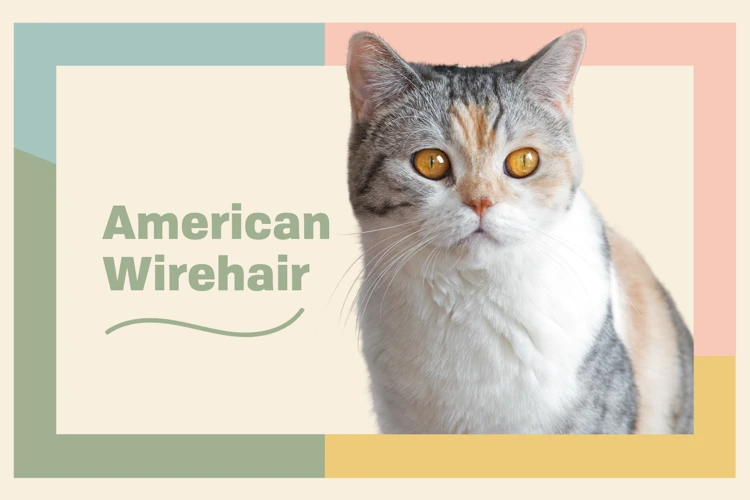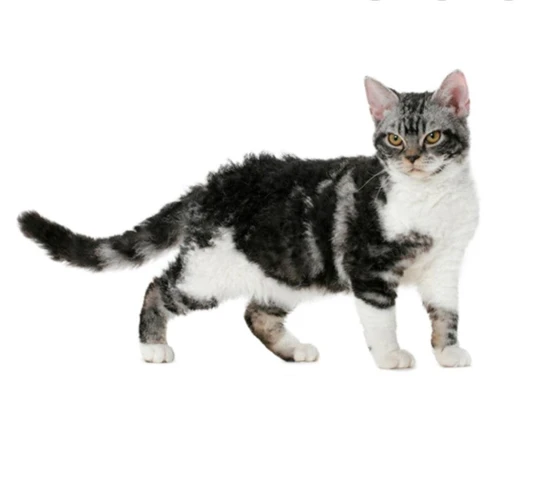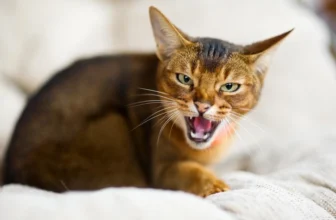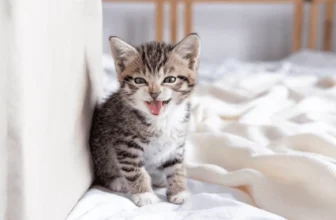If you’re a cat owner who has noticed their furniture becoming increasingly damaged over time, you might be wondering why your beloved American Wirehair is so intent on scratching your couch. Furniture scratching is a natural behavior for cats, but it can be frustrating and expensive for their human companions. In this article, we’ll explore the territorial nature of American Wirehairs and how it relates to furniture scratching. We’ll also discuss the benefits of scratching for cats, and provide tips and strategies to prevent damage to your furniture without compromising your cat’s natural instincts. So, let’s dive into the world of American Wirehairs and find out how to create a happy and scratch-free home for you and your pet.
Why Are American Wirehairs Territorial?

It’s no secret that American Wirehairs can be quite territorial creatures, but the reasons behind this behavior may not be immediately clear. Understanding why your furry friend is so protective of their space is key to helping them feel comfortable and content in your home. According to experts, the roots of territoriality in cats are grounded in their evolution, and American Wirehairs have a particularly unique personality that can contribute to their territorial tendencies. This can be a contributing factor to why American wirehairs scratch furniture. Let’s take a closer look at what makes these cats so territorial.
The Evolutionary Origins of Territorial Behavior in Cats
One fascinating reason why cats exhibit territorial behavior is their evolutionary origins. According to scientists, wild cats that roamed thousands of years ago had to protect their resources, such as food and shelter, to survive. This led to the development of territorial behavior as a survival instinct. Even though domesticated cats in modern times no longer need to fight for survival, their instinctual behavior remains unchanged.
However, American Wirehairs have a particularly strong territorial nature due to their genetics. As a breed that originated on farms, they used to hunt rodents to protect the crops. This innate desire to protect their territory has carried over to their personality, making them more prone to displaying territorial behavior compared to other cat breeds.
Understanding a cat’s territorial nature can help owners provide a conducive environment for their pets. By providing appropriate scratching surfaces and enriching their surroundings, owners can help their cats feel more secure and less likely to engage in destructive behavior such as furniture scratching.
To learn more about why American Wirehairs scratch furniture, read on to the next section. Or, if you’re looking for ways to prevent your cat from scratching your furniture, skip ahead to the section on how to prevent furniture scratching in American Wirehairs.
The Unique Personality of American Wirehairs
American Wirehairs are a unique breed of cat that is known for its distinctive wiry coat and amiable disposition. These cats are often described as being friendly, energetic, and intelligent, which makes them excellent companions for families with children or other pets.
Playfulness: One of the most notable aspects of the American Wirehair’s personality is their love for playfulness. They are very active and can often be seen running around and jumping from one piece of furniture to another. This energy makes them ideal pets for households that have children or other pets.
Loyalty: American Wirehairs are known for their loyalty and devotion to their owners. They are always eager to please and will often follow their owners around the house. This loyalty can make them excellent therapy animals and emotional support animals.
Independent streaks: Despite their loyalty, American Wirehairs are also known for their independent streaks. They like to have their own space and may not always seek out attention from their owners. This independent nature can sometimes make them seem aloof, but in reality, they are just enjoying their own company.
Curiosity: American Wirehairs are also very curious cats and enjoy exploring new environments. This curiosity can sometimes get them into trouble, as they may wander into areas where they shouldn’t be. However, it also makes them very entertaining pets to watch.
Affectionate: While American Wirehairs may have independent streaks, they are also very affectionate cats. They enjoy cuddling with their owners and will often seek out attention when they are in the mood for some extra affection.
American Wirehairs have a unique and endearing personality that make them excellent pets. Their playfulness, loyalty, independence, curiosity, and affectionate nature make them a great addition to any household.
Why Do American Wirehairs Scratch Furniture?

It can be perplexing and frustrating when your American Wirehair scratches on your furniture. You may be left wondering why they engage in such behavior, and what you can do to prevent it. Cats have an instinctual need to scratch, but your furniture doesn’t have to suffer as a result. There are several reasons why American Wirehairs scratch furniture, and understanding these reasons is the first step in preventing it. Let’s take a closer look at the motives behind this behavior so you can find a solution that works for both you and your cat. To find more about alternative solutions to declawing an American Wirehair, read our article “Alternatives to Declawing Your American Wirehair”. If you are interested in teaching this breed how to scratch appropriate surfaces, click on this link: “How to Teach Your American Wirehair to Scratch on Appropriate Surfaces”.
The Physical and Emotional Benefits of Scratching for Cats
While scratching can be destructive to furniture, it actually provides physical and emotional benefits for cats. Here are some of the ways scratching is beneficial for your American Wirehair:
- Sharpening Claws: Scratching removes the outer layer of the claw, sharpening it and allowing your cat to defend itself and climb more easily.
- Stretching Muscles: Scratching provides a full-body stretch for your cat, helping to keep muscles and tendons healthy and flexible.
- Marking Territory: As mentioned earlier, scratching is a way for cats to mark their territory with scent. This can reduce stress and anxiety in cats by creating a sense of security in their environment.
- Relieving Stress: Scratching also helps to relieve stress and frustration in cats. This is because scratching releases endorphins, which are natural stress-relievers.
It’s important to remember that scratching is a natural behavior for cats and is necessary for their physical and emotional well-being. Rather than trying to completely eliminate scratching, it’s better to provide appropriate surfaces for your American Wirehair to scratch and train them to avoid furniture.
The Relationship Between Territoriality and Scratching
When it comes to American Wirehairs, their territorial nature is closely tied to their scratching behavior. Scratching is a natural instinct that allows cats to mark their territory, stretch their muscles, and sharpen their claws. It is not a destructive behavior when directed towards appropriate surfaces. However, when scratching is focused on furniture, it can become problematic for both the cat and their owners.
The territoriality of American Wirehairs is a key reason why they scratch furniture. These cats view their home as their territory, and they need to mark it with their scent and scratching marks. If they feel that their territory is threatened, they will scratch more frequently in an attempt to protect it. This behavior can be amplified if there are other cats in the household or if there are changes in the environment, such as new furniture or a new person coming into the house.
In addition to the territorial aspect, scratching also serves as a form of communication for American Wirehairs. By scratching furniture, they are telling other cats (even if there are no other cats in the household) that this is their territory. They may also be expressing emotions such as frustration, anxiety, and boredom.
The relationship between territoriality and scratching is not always negative. In fact, providing appropriate scratching surfaces can help satisfy American Wirehair’s need to mark and protect their territory. By providing a designated scratching post or pad, owners can give their cats an appropriate outlet for this behavior. Additionally, having multiple scratching locations throughout the house can also help reduce competition between cats.
The relationship between territoriality and scratching is complex. While scratching is a natural and necessary behavior for cats, it can become destructive if directed towards furniture. Understanding the reasons behind American Wirehair’s scratching behavior can help owners provide appropriate solutions to prevent damage to furniture and keep their cats happy and healthy.
| Key Points: |
|---|
| Scratching is a natural instinct that allows cats to mark their territory. |
| American Wirehairs view their home as their territory and need to mark it with their scent and scratching marks. |
| Scratching also serves as a form of communication. |
| Providing appropriate scratching surfaces can help satisfy American Wirehair’s need to mark and protect their territory. |
| Understanding the reasons behind American Wirehair’s scratching behavior can help owners provide appropriate solutions to prevent damage to furniture. |
How to Prevent Furniture Scratching in American Wirehairs
As a pet owner, it can be frustrating to come home to find your furniture scratched and damaged by your beloved American Wirehair. However, it’s important to understand that scratching is a natural instinct for cats and is crucial for their physical and emotional well-being. Instead of trying to stop your cat from scratching altogether, the key is to redirect their scratching behavior to appropriate surfaces and create an environment that satisfies their natural instincts. In this section, we’ll discuss some effective strategies for preventing furniture scratching in your American Wirehair.
Provide Appropriate Scratching Surfaces
Cats scratch to keep their claws healthy and mark their territory. Providing appropriate scratching surfaces for American Wirehairs is essential to prevent them from scratching furniture. An appropriate scratching surface should be sturdy and tall enough to allow your cat to stretch while scratching. Here are some examples of appropriate scratching surfaces:
| Scratching surface | Description |
|---|---|
| Scratching post | A tall and sturdy post made of sisal rope, carpet, or cardboard. |
| Scratching pad | A flat pad made of corrugated cardboard that can be placed on the floor or mounted on a wall. |
| Scratching tower | A tall and multi-leveled structure that provides several surfaces for scratching and jumping. |
It’s important to observe your cat’s scratching habits and preferences. Some cats prefer horizontal scratching surfaces, while others prefer vertical ones. You may need to provide both types of surfaces to determine what your American Wirehair prefers. Additionally, placing scratching surfaces in the areas where your cat likes to scratch furniture may also help redirect their behavior.
Remember to reward your American Wirehair with treats or affection when they use their appropriate scratching surfaces. This positive reinforcement will encourage them to continue using them. Providing appropriate scratching surfaces is an effective way to prevent furniture scratching in American Wirehairs.
Use Deterrents to Discourage Scratching on Furniture
Scratching is a natural behavior for cats, but that doesn’t mean their chosen scratching posts are always acceptable. If your American Wirehair continues to scratch the furniture even after providing alternative materials, deterrents may be necessary. Here are some effective deterrent options:
| Deterrent Method | Pros | Cons |
|---|---|---|
| Double-sided tape | Effective, yet harmless option that cats don’t like the feel of. Can be used on furniture or floors. | May be less effective for cats who are used to textures like carpet or other rough materials. Tape may leave residue. |
| Bitter sprays | Many of these sprays are made with natural ingredients and are safe for both humans and cats. The unpleasant taste deters cats from scratching. | May require frequent re-application and may not be effective for all cats. |
| Noise deterrents | Devices that emit high-pitched noises or other unpleasant sounds can be an effective deterrent to scratching. Some owners have success using their own voice to scold the cat when caught in the act of scratching inappropriate surfaces. | May be annoying for humans as well as cats. May not work for all cats and some may become desensitized to the noise over time. |
| Scent deterrents | Using scents that cats dislike, such as citrus or menthol, can discourage scratching. These deterrents can be used on furniture or sprayed on alternative scratching surfaces to encourage their use. | May require frequent re-application and may not be effective for all cats. The scent may also be unpleasant for humans. |
It’s important to remember that while deterrents may be effective in preventing furniture scratching, they should be used in conjunction with positive reinforcement training and appropriate scratching materials to ensure long-term success. By providing a variety of acceptable scratching surfaces and discouraging inappropriate scratching behavior, your American Wirehair can live a happy and healthy life while preserving the beauty of your home.
Enrich Your American Wirehair’s Environment
Enrich Your American Wirehair’s Environment: In addition to providing appropriate scratching surfaces and using deterrents, it’s important to enrich your American Wirehair’s environment to prevent furniture scratching. This means providing plenty of mental and physical stimulation for your cat, which can reduce stress and anxiety and redirect their energy away from destructive behaviors like scratching.
One way to enrich your cat’s environment is to provide plenty of toys. Toys that mimic the movement and behavior of prey animals, like mice and birds, are particularly effective at keeping cats engaged and entertained. Interactive toys, like feather wands and laser pointers, can also keep your cat active and mentally stimulated.
Another way to enrich your American Wirehair’s environment is to provide them with access to high places. Cats naturally like to survey their surroundings from a high vantage point, and providing them with a cat tree or shelving units can allow them to do this safely. This can also help to reduce conflict between multiple cats in your household, as each cat can have their own territory.
Outdoor enclosures and window perches also provide opportunities for mental and physical stimulation. These can allow your American Wirehair to experience the sights, sounds, and smells of the outdoors in a safe and controlled environment, which can reduce boredom and prevent destructive behavior.
Finally, it’s important to rotate your cat’s toys and playtime activities regularly. This can keep them engaged and prevent boredom, which can lead to destructive behaviors. By following these tips and providing your American Wirehair with a stimulating and enriching environment, you can help prevent furniture scratching and promote a happy and healthy relationship with your feline friend.
| Tips for Enriching Your American Wirehair’s Environment: |
| ————- |
| Provide plenty of toys that mimic prey animals and offer interactive play |
| Give your cat access to high places, like cat trees and shelving units |
| Provide outdoor enclosures or window perches for stimulation and entertainment |
| Rotate toys and playtime activities regularly to prevent boredom |
Play With Your Cat Regularly
Regular playtime is essential for the happiness and well-being of American Wirehairs, and it can also help reduce their furniture scratching behavior. By engaging in positive play sessions with your cat, you provide them with an outlet for their natural instincts and energy, which can reduce their desire to scratch furniture. Here are some tips for effective play sessions with your American Wirehair:
- Use interactive toys: Toys that require your participation, such as a feather wand or laser pointer, can stimulate your American Wirehair’s hunter instincts and provide them with a fun and challenging game to play.
- Set aside dedicated playtime: Make sure to set aside at least 10-15 minutes per day to play with your cat. Consistency is key, so try to stick to a regular schedule.
- Experiment with different types of play: Some American Wirehairs prefer chasing toys, while others prefer to pounce or bat at them. Try out different types of toys and play styles to see what your cat enjoys the most.
- Provide positive reinforcement: Encourage your American Wirehair to engage in play with positive reinforcement, such as treats or praise. This will help reinforce the behavior and make your cat more likely to engage in play in the future.
Remember, every American Wirehair is different, so it’s essential to pay attention to your cat’s preferences and play style. With a bit of trial and error, you can create a playtime routine that both you and your American Wirehair will enjoy, and help reduce their furniture scratching behavior in the process.
Train Your Cat with Positive Reinforcement
When it comes to preventing furniture scratching in American Wirehairs, positive reinforcement training can be a highly effective technique. Here are some tips for training your cat with positive reinforcement:
1. Start with a Scratch Post
Begin by teaching your American Wirehair to scratch an appropriate surface, such as a scratch post. Place the post near the furniture your cat has been scratching, and encourage your cat to use it by rubbing some catnip on it or attaching a toy to it. Whenever your cat uses the scratch post, reward them with a treat or praise.
2. Punishment is Not the Answer
Remember, punishment is not an effective training method for cats. Punishing your cat for scratching furniture will only make them fearful and anxious, and they may start to associate you with unpleasant experiences. Instead, focus on rewarding positive behavior.
3. Consistency is Key
Consistency is important when training your American Wirehair. Make sure everyone in your household is on board with the training plan and follows the same rules. Be patient and consistent in rewarding good behavior, and don’t give up if your cat doesn’t catch on right away.
4. Use Positive Reinforcement Techniques
Positive reinforcement involves rewarding good behavior, rather than punishing bad behavior. When your cat uses the scratch post or refrains from scratching furniture, reward them with treats, praise, or playtime. This will reinforce the desired behavior and encourage your cat to repeat it in the future.
5. Provide Plenty of Enrichment
Cats need mental and physical stimulation to stay happy and healthy. Provide your American Wirehair with plenty of toys, scratching posts, perches, and hiding places to keep them entertained. A bored cat is more likely to engage in destructive behavior, like scratching furniture, so keeping your cat enriched is key to preventing furniture scratching.
Positive reinforcement training can be an effective way to prevent furniture scratching in American Wirehairs. By providing appropriate scratching surfaces, using deterrents, enriching your cat’s environment, playing with them regularly, and training them with positive reinforcement, you can help your American Wirehair develop good scratching habits and keep your furniture safe.
Conclusion
After learning about the territorial nature of American Wirehairs and how it relates to furniture scratching, it is clear that cat owners must understand and accommodate for their cat’s natural instincts. Providing appropriate scratching surfaces, using deterrents, enriching the environment, playing regularly, and training with positive reinforcement are all important steps in preventing furniture scratching.
It is important to remember that American Wirehairs have unique personalities and may require different types of scratchers or training methods compared to other cat breeds. As a cat owner, one must be patient, understanding, and flexible in order to find what works best for their individual pet.
Overall, the key takeaway is that furniture scratching is a natural behavior for American Wirehairs and other cats. By providing appropriate outlets for this behavior and creating a enriched environment, you can avoid damaging furniture and strengthen the bond between you and your furry friend. Remember, happy cats make happy owners.
Frequently Asked Questions
What is the average lifespan of an American Wirehair?
An American Wirehair has an average lifespan of 12-16 years.
Do American Wirehairs shed a lot?
American Wirehairs have a thick coat that sheds moderately, but regular grooming can help to reduce shedding.
Are American Wirehairs good with children?
American Wirehairs are generally good with children as long as they are treated with care and respect.
Do American Wirehairs get along with other pets?
American Wirehairs can get along well with other pets if they are introduced properly and socialized from a young age.
Are American Wirehairs prone to any health issues?
American Wirehairs are generally a healthy breed, but they may be prone to hypertrophic cardiomyopathy (HCM) as well as gastrointestinal issues.
How often should I groom my American Wirehair?
American Wirehairs should be groomed at least once a week to remove loose fur and prevent matting.
What is the best type of scratching post for an American Wirehair?
The best type of scratching post for an American Wirehair is one that is tall enough for them to fully stretch and made of a rough material like sisal or cardboard.
Can declawing prevent furniture scratching in American Wirehairs?
No, declawing is an inhumane and unnecessary procedure that can lead to physical and behavioral problems in cats.
Do American Wirehairs need a lot of space to live in?
American Wirehairs are adaptable and can live comfortably in smaller spaces as long as they have enough space to play and exercise.
Are American Wirehairs high-maintenance pets?
American Wirehairs have a low-maintenance coat and are generally easy to care for, but they do require regular play and social interaction to prevent behavioral issues.







